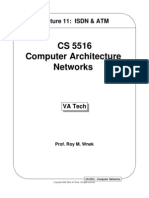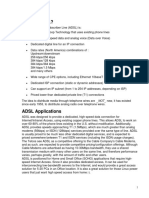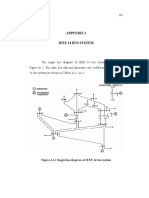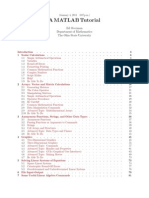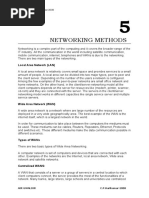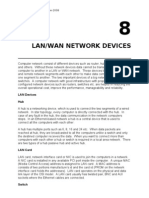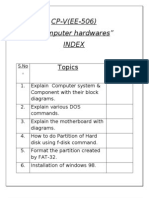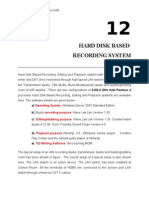Introduction To Isdn Line
Uploaded by
VIKALP KULSHRESTHAIntroduction To Isdn Line
Uploaded by
VIKALP KULSHRESTHAVocational Training Course-2008
11
INTRODUCTION TO ISDN LINE
Find here ISDN Network, introduction to ISDN line, bri, t1 lines, d1 lines, primary rate
interface, connection time and setup instructions. The regular phone line, which is
used at home and offices is an analogue phone line. Your voice is picked up by
telephone mouthpiece and then sent down the phone line as an analogue wave.
Regular modem converts the digital signals of the computer into the analogue
waves, which then travels on the regular phone lines. At the other end, modem
receives that analogue signals and then convert back into the digital signals that are
understandable by a computer
ISDN network is a digital communication system that is capable of producing the
maximum transmission speed of 1.4Mbps. 128Kbps speed is however more
common in the digital technology. It's a international standard for sending data,
voice, video over regular digital telephone lines. ISDN uses UTP (unshielded twisted
pair cable) for transmission.
Types of ISDN Network
There are two basic types
• Basic Rate Interface (BRI) – It consists of two 64 B-channels and one D-channel for
transmitting control information.
• Primary Rate Interface (PRI) -- It consists of 23 B-channels and one D-channel (for
U.S.) or 30 B-channels and one D-channel (for Europe).
The actual version of ISDN employs base band transmission. Another version, called
B-ISDN, uses broadband transmission, which is able to support transmission rate of
1.5 Mbps. B-ISDN mainly requires fiber optic cables.
To access the B channel, it is necessary to subscribe the ISDN phone line.
Customers are also required to have some special ISDN devices, which are known
as terminal adapters, which are used to communication with the telephone company
switch or other ISDN devices.
How ISDN Works
In an analog network, a regular telephone line that is provided by the telephone
company supports a single transmission channel, which normally can carry only one
AIR GWALIOR C.P.Harikumar-2008
Vocational Training Course-2008
service, voice, data or video at a single time. With ISDN, this same pair telephone
line is logically divided into the multiple channels. A typical line has two channels.
The first type of channel is called B channel. This channel can carry about 64Kbps of
data. Typical ISDN line has 2 B channels. One channel is used for voice and other
channel is used for data communication. This data/voice transmission process
occurs on the regular one pair copper wire.
The second type of channel is used for link and call setup. This channel is known as
D channel or Delta Channel.
The third channel has only 16Kbps of bandwidth.
Advantages
Speed
There is an upper limit of the speed in the commonly used dial up modems, which is
56kbps. But due to the quality and other factor, the maximum attainable speed is
45kbps.
ISDN allows multiple digital channels to operate simultaneously through the same
regular one pair copper wire. If the telephone company supports the digital
connections then a change can occur. The digital signals instead of the analogue
signals, transmitted across the telephone line. In the digital scheme, there is much
more data transfer rate than the analog lines.
Multiple Devices
A separate telephone line is required for using the fax, telephone, computer, router
and live video conferencing systems. A separate line is required for each device.
ISDN network lines can handle the multiple devices on the single line. Up to eight
devices such as, computer, faxes, cash registers, credit card readers or other
devices can directly be connected to a single ISDN line, all these devices can work
simultaneously.
Connection Time
V.34 modems typical take 30-60 seconds to establish a connection and on the other
end an ISDN call usually takes less than 2 seconds to establish a connection.
Disadvantages
There are some disadvantages of the ISDN lines, which I have discussed below.
1. ISDN is more expensive than the Plain old telephone system.
2. The telephone company and the ISDN user both are required to have the
specialized digital devices.
ADSL VS ISDN
There is a noticeable difference between the two services.
• ISDN provides two voice channels or one 128Kbps data channel while ADSL is
basically a data pipe.
• The power for ADSL is sent by carrier over copper wire; as with the local phone
AIR GWALIOR C.P.Harikumar-2008
Vocational Training Course-2008
service. The line works even when local power fails. This is an advantage over the
ISDN lines, which requires the local power supply.
****
AIR GWALIOR C.P.Harikumar-2008
You might also like
- Integrated Services Digital Network (ISDN)No ratings yetIntegrated Services Digital Network (ISDN)16 pages
- Integrated Services Digital Network: An Assignment OnNo ratings yetIntegrated Services Digital Network: An Assignment On12 pages
- New Microsoft Office Power Point Presentation 24No ratings yetNew Microsoft Office Power Point Presentation 2418 pages
- Unit 3 The Physical Layer: Btech Extc Trim IX Faculty: Prof. Sonia RelanNo ratings yetUnit 3 The Physical Layer: Btech Extc Trim IX Faculty: Prof. Sonia Relan14 pages
- How Integrated Services Digital Network Works?No ratings yetHow Integrated Services Digital Network Works?2 pages
- Integrated Services" "Digital Network: Isdn - " "No ratings yetIntegrated Services" "Digital Network: Isdn - " "6 pages
- CS 5516 Computer Architecture Networks: Lecture 11: ISDN & ATMNo ratings yetCS 5516 Computer Architecture Networks: Lecture 11: ISDN & ATM26 pages
- Title: ISDN (Integrated Services Digital Network)No ratings yetTitle: ISDN (Integrated Services Digital Network)15 pages
- ISDN Elements: Integrated Services Digital Network (ISDN) Is A Set of Communications Standards ForNo ratings yetISDN Elements: Integrated Services Digital Network (ISDN) Is A Set of Communications Standards For3 pages
- Integrated Services Digital Network RevisedNo ratings yetIntegrated Services Digital Network Revised2 pages
- What Is The Difference Between ISDN and DSL?: DefinitionsNo ratings yetWhat Is The Difference Between ISDN and DSL?: Definitions2 pages
- Seminar Report On Integrated Services Digital Network (ISDN)100% (1)Seminar Report On Integrated Services Digital Network (ISDN)26 pages
- 3 - Connectivity - Dial Up, Leased Lines, ISDN, Digital Subscriber LinesNo ratings yet3 - Connectivity - Dial Up, Leased Lines, ISDN, Digital Subscriber Lines28 pages
- Using Telephone and Cable Networks For Data TransmissionNo ratings yetUsing Telephone and Cable Networks For Data Transmission15 pages
- Nepal Telecom Exam Preparation (Level 7) : Dipak Kumar NidhiNo ratings yetNepal Telecom Exam Preparation (Level 7) : Dipak Kumar Nidhi40 pages
- Module 2 - Lesson 2 How The Internet WorksNo ratings yetModule 2 - Lesson 2 How The Internet Works34 pages
- 1485333 Using Telephone and Cable Networks for Data Transmission CSET 221 Computer Networking Farhan KhanNo ratings yet1485333 Using Telephone and Cable Networks for Data Transmission CSET 221 Computer Networking Farhan Khan34 pages
- Digital Lines and The Integrated Service Digital Network (ISDN)No ratings yetDigital Lines and The Integrated Service Digital Network (ISDN)41 pages
- Switching Systems: Dr. Kenedy Aliila GreysonNo ratings yetSwitching Systems: Dr. Kenedy Aliila Greyson31 pages
- EN8060 Telecommunications B_08_ADSL_Ethernet_WiFiNo ratings yetEN8060 Telecommunications B_08_ADSL_Ethernet_WiFi75 pages
- Integrated Services Digital Network (ISDN)No ratings yetIntegrated Services Digital Network (ISDN)26 pages
- Name-Madhav Khandelwal M.Tech (NTC) Roll No - 19 Assignment - Broadband and Multimedia TechnologyNo ratings yetName-Madhav Khandelwal M.Tech (NTC) Roll No - 19 Assignment - Broadband and Multimedia Technology9 pages
- Networking Methods: Local Area Network (LAN)No ratings yetNetworking Methods: Local Area Network (LAN)4 pages
- Practical File On Electronic-II: Submitted To Submitted byNo ratings yetPractical File On Electronic-II: Submitted To Submitted by16 pages
- Radar Fundamentals Power Point Presentation100% (3)Radar Fundamentals Power Point Presentation51 pages
- Byte Con Fiden Tial Don Otc Opy: Model Name: Ga-H110M-S2HNo ratings yetByte Con Fiden Tial Don Otc Opy: Model Name: Ga-H110M-S2H50 pages
- Letter From Department of State General Counsel Brad McvayNo ratings yetLetter From Department of State General Counsel Brad Mcvay2 pages
- Wind Turbine - Wikipedia, The Free EncyclopediaNo ratings yetWind Turbine - Wikipedia, The Free Encyclopedia17 pages
- Lr2170sa 4ah Specification Sheet TranslatedNo ratings yetLr2170sa 4ah Specification Sheet Translated15 pages
- 2018-19 - Sydney Opera House Annual Report - LR SpreadsNo ratings yet2018-19 - Sydney Opera House Annual Report - LR Spreads108 pages
- 03 Wheel Loader Typical Failure Analysis Mannul-AxleNo ratings yet03 Wheel Loader Typical Failure Analysis Mannul-Axle37 pages
- Characterization and Reuse of Kiln Rollers Waste in The Manufacture of Ceramic Floor TilesNo ratings yetCharacterization and Reuse of Kiln Rollers Waste in The Manufacture of Ceramic Floor Tiles7 pages
















